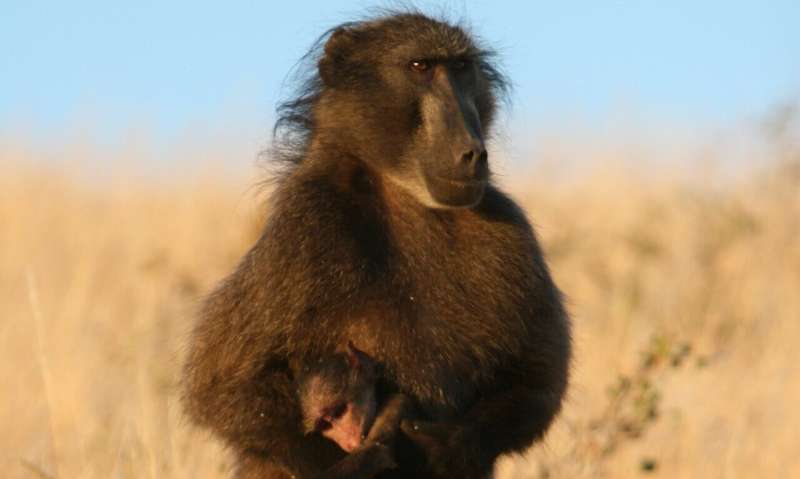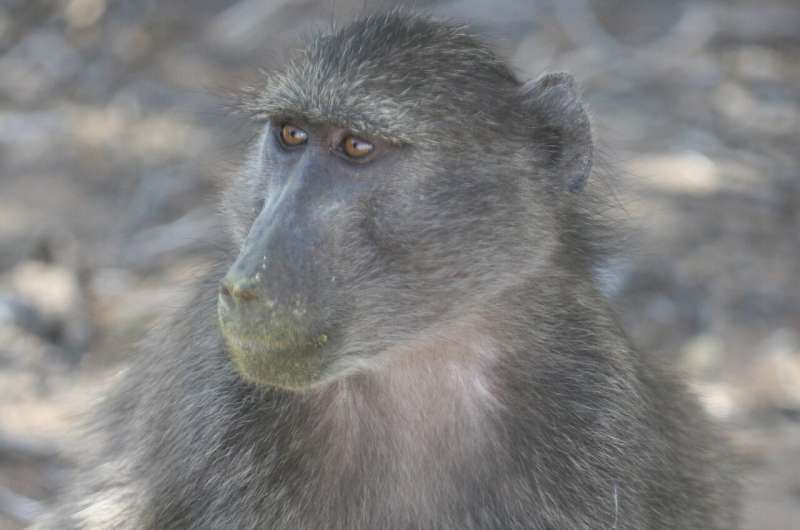Baboon mothers carry their dead infant up to 10 days

Baboon mothers living in the wild carry dead infants for up to ten days, according to a new study led by UCL and Université de Montpellier.
The research, published in Royal Society Open Science, is the most extensive study on baboons, reporting on 12 cases of group responses to infants' deaths, including a miscarriage and two stillbirths, recorded over 13 years in wild Namibian chacma baboons.
Chacma baboons live in large multi-sex groups, with strong linear male and female hierarchies. One group of baboons can range anywhere from 20 to 100 primates.
Anthropologists observed baboon mothers in the Namibian desert carrying dead infants for varying lengths of time, ranging from one hour to ten days, with the average length being three to four days. During this time the mother grooms the dead infant frequently.
Lead author, Dr. Alecia Carter (UCL Anthropology and Université de Montpellier), said: "There are numerous hypotheses to explain primate responses to dead infants. Perhaps the strongest hypothesis is that carrying after death is an extension of nurturing behaviour.
"We are not suggesting that the mothers are unaware that their infants are dead, but there is such strong selection on mother-infant bond formation that, once formed, the bond is difficult to break. It's less clear why only some mothers carry or protect their dead infant, but I suspect that a range of factors influence this behaviour."

While there are a number of hypotheses, the researchers believe the most plausible are the 'grief-management hypothesis', which suggests that mothers carry the dead infant as a way of dealing emotionally with their loss, and the 'social-bonds hypothesis' which suggests that mothers carry their infants because of the intense social bond mothers and infants share during life.
Other possible explanations for the behaviour include the 'unawareness hypothesis' which suggests that the mother lacks the cognitive ability to discriminate between 'dead' and 'unresponsive but alive', and that continued care is ultimately an adaptive behaviour in case the unresponsive individuals recover.
Primate mothers are unlikely to be unaware that their infants are dead, however, as they treat the corpse very differently to live infants, even if they are sick and lethargic. For example, dead infants are frequently carried by a limb or dragged along the ground; this is never done with live infants.
Researchers believe a range of factors influence the length of time a mother carries her dead infant, including the mothers' age, infant cause of death and the climate conditions.

Dr. Carter adds: "Other primates have been observed carrying their dead infants for much longer periods of time. Chimps and Japanese macaques for example have been observed carrying infants for over a month. However, chacma baboons travel much longer distances on an average day and the desert environment is harsh, making it costly for a mother to carry her infant for long periods."
The researchers also observed that male 'friends' - who had been associated with the mother and her infant during its life and are usually the fathers of the infant—protect the dead infant, either by threatening observers that came close or, on one occasion, sitting near and grooming the dead infant when the mother moved away temporarily.
Last author on the study, Dr. Elise Huchard (Université de Montpellier), said: "This is quite surprising behaviour, because it has rarely been reported by previous studies. Male baboons are not usually very paternal, but they regularly protect their infant from threats, especially from infanticidal attacks. That is where a male baboon kills another male's offspring in order to mate with the mother."
More information: Alecia J. Carter et al. Baboon thanatology: responses of filial and non-filial group members to infants' corpses, Royal Society Open Science (2020). DOI: 10.1098/rsos.192206
Journal information: Royal Society Open Science
Provided by University College London





















